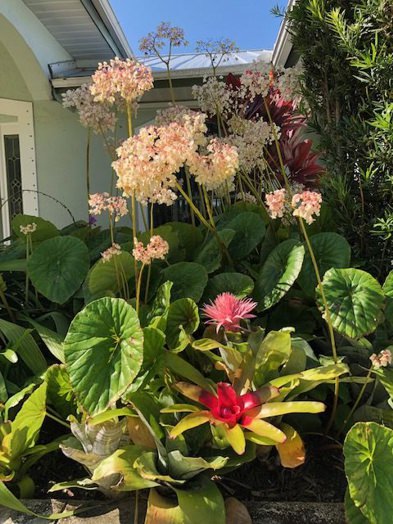
Gardening was part of my childhood experience: picking violets at grandmas and pansies at home, eating grapes off the vine at nanas and vegetables from grandad’s garden, and admiring my aunt’s azaleas. And those gardening seeds planted in childhood propagated when I was an adult, first with apartment house plants and then outdoor gardens as a home owner.
National Gardening Day on April 14th got me digging into the merits of gardening for people with disabilities. I was drawn to the aesthetics of indoor plants, but never thought about their role in removing air contaminants and increasing humidity in dry areas. I didn’t know plants lowered my stress and blood pressure and improved my mood. For example, my snake plant that relocated with me three times had apparently eliminated air pollutants, reduced tension, and promoted relaxation.
Want to subscribe to receive blog updates sign up today!
I knew outdoor gardening supplemented my Vitamin D intake, but had no idea the sun lowers my risk of certain cancers and other maladies. The exercise involved saves me from a gym membership, promotes sleep, helps maintain a healthy weight, reduces stress, and improves cognitive skills.
In recent years, these advantages are recognized as therapeutic horticulture used in hospitals, rehabilitation centers, senior centers, schools, and prisons. Patients with catastrophic injuries are observed to heal faster when they access outdoor spaces with plants. British primary-care doctors often give patients a “social prescription” for gardening as an effective alternative to talk therapy or antidepressants.
However, in order for me to benefit from therapeutic gardening I need a garden that accommodates my inability to kneel, touch my toes, and stand for any length of time. When designing the garden next to our front door, some plants were kept in reach as a border next to the sidewalk and others adjacent to a circular pathway around the garden interior. Underground watering was linked to the lawn sprinkler. Weeding was reduced with mulch. Dead leaves and flowers on the begonias, bromeliads, and anthuriums were plucked with salad tongs. Debris was gathered in a throw away grocery bag. Gardening for the day stopped when the bag was full.

For 22 years my tropical garden in our Florida climate thrived. But time has left its’ mark with a broken watering system, ups and downs in the soil level, and spreading plants almost eliminating my pathway. This year’s cold spell almost wiped out some plants and many dead leaves weren’t plucked given my lack of access.
My friend Susan helped me clean up the garden, but going forward accessible features are needed. As a retiree on a fixed income, I need affordable options that don’t involve starting from scratch. To avoid kneeling, bending down, and plants spreading into the walkway, I’m exploring easy watering like a seep hose for containers and a raised bed built to my height with plants that won’t grow out of reach. Hanging planters with a pulley system would be cool. Ergonomic light weight tools with a comfortable grip and long reach range are necessary.
What accessible gardening tips can you add?
You may also want to read:
- Jess Richmond, Bruce Dunn. “The History of Therapeutic Horticulture. February 2023|Id: HLA-6472. https://extension.okstate.edu/fact-sheets/therapeutic-horticulture.html
- Rebecca Joy Stanborough. “Seed, Soil, and Sun: Discovering the Many Healthful Benefits of Gardening.” June 17, 2020. https://www.healthline.com/health/healthful-benefits-of-gardening
- “10 Mental Health Benefits of Gardening.” June 19, 2019. https://www.psychologytoday.com/us/blog/think-act-be/201906/10-mental-health-benefits-gardening
- Jill Morgan. “Accessible Garden Design: 15 ideas for landscaping, paths, planting and more.” https://www.gardeningetc.com/design/accessible-garden-design
- “Accessible, No Barriers Gardening (Or Things the ADA May Not Tell You).” University of California: Agriculture and Natural Resources. https://ucanr.edu/sites/mgfresno/Central_Valley_Gardening_with_Master_Gardeners/Projects/Accessible_Gardening_147/
- Ron. “The Best Tips On Wheelchair Accessible Gardening.” January 18, 2023. https://adaptivelivingaids.com/wheelchair-accessible-gardening/
- Chloe Deike. “Adaptive Tools for Gardeners.” https://www.gardengatemagazine.com/articles/how-to/plant/accessible-tools-for-gardeners/

3 replies on “Therapeutic Gardening and Accessibility”
Preen can be sprinkled on your flower bed to prevent new weed seeds from germinating. Saves a ton of weeding.
Let me know what innovations you would like done. I would be pleased to do them. It would be exciting.
KT
How exciting! I would so enjoy helping with revamping Angela’s garden. I like playing in the dirt, so count me in for the labor if needed. She has begonia popenoei and aechmea fasciata bromeliad and some kind of ground orchid with purple flowers. Susan